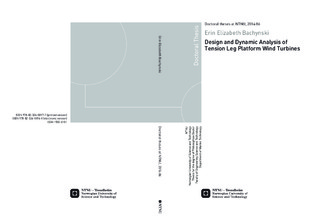| dc.description.abstract | There is an increasing interest in using wind turbines oshore, and in deeper water. The tension leg platform wind turbine (TLPWT) concept is promising for intermediate (45 - 150 m) or deep (> 150 m) water. The limited platform motions are expected to reduce the structural loading on the tower and blades compared to other floating concepts, without requiring the large draft of a spar or the spread mooring system and complex construction of a semi-submersible. Although numerous TLPWT designs exist on paper, there is very little consensus regarding size, tendon design, and analysis requirements. In order to determine whether or not such concepts could be feasible and to lead the way for future optimization work, a better understanding of how design choices aect the global system performance, an investigation of potential design-driving load cases, and an evaluation of the simulation sensitivity are required.
TLPWT systems are complex and dynamic: time-varying environmental loads from the sea, soil, and air act on a exible integrated structure with a wide range of natural frequencies. Furthermore, the wind turbine may enter and exit various operational, start-up, shut-down, and failure modes. Dynamic simulation of TLPWTs requires multidisciplinary consideration of aerodynamics, hydrodynamics, control systems, and structural mechanics. Frequency-domain methods from oshore structures are not well-suited to the exible structure and wind forces, while the computationally intense simulations common to the wind turbine industry are impractical with respect to the long time series required to capture wave- and low-frequency dynamics.
A new computational tool (SIMO-RIFLEX-AeroDyn) was developed and used to examine both the design and analysis of TLPWTs. The combination of three well-known codes under a single structural solver gave a stable, state-of-the-art numerical tool for analysis of floating wind turbines. Additionally, the wind turbine control system was implemented in Java, including options for applying a control system fault at an arbitrary point in time. This framework enabled detailed studies of parametric design effects, comparisons of different hydrodynamic models using a single structural model - including the implementation of a different ringing force model - and simulation of off-design conditions.
This thesis presents several baseline designs based on a parametric approach. Preliminary coupled simulations using first order wave forces suggested that a reasonable single column design with displacement between 3500 and 6500 m3, three pontoons (for easier installation), and pontoon radius between 28 and 35 m, may be able to support a 5 MW wind turbine and withstand harsh environmental conditions. Having established these designs as test cases, various analysis methods were compared. Neither linear frequency-domain analysis nor Morison-type forces gave acceptable results. Second-order sum-frequency wave forces were found to be important for fatigue and extreme response calculations for certain TLPWTs, particularly those with relatively soft tendons. Third order ringing forces were found to be critical for TLPWTs with large diameters (14-18 m), especially when the turbine was idling or parked. Finally, the analysis tool was extended to several different severe operational conditions. Control system faults were found to cause large tower top loads and yaw motions for TLWPTs, while wind-wave misalignment resulted in generally smaller responses than aligned conditions. Second-order forces, however, had a greater impact in misaligned wind and waves than in aligned conditions.
The original contributions of this thesis - including participation in developing the novel analysis tool (and the implementation of ringing loads), the development of a simplifed design method, and the presented simulation results - provide the background for further studies of TLPWTs and other floating wind turbine concepts. | nb_NO |
